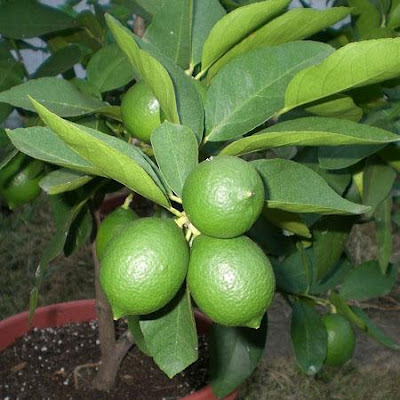Q. I have a Bearss Lime tree that produces small fruit that looks more like lemons than limes. What can I do to make them larger and not yellow but green?
A. Your Bearss lime is classified as a type of Persian lime or sometimes called Tahiti lime. It’s different from other types of limes so make sure you are comparing the same varieties. They make good patio trees if potted and can be moved when it gets too cold. They will freeze any time the air temperature is below freezing. The fruit normally gets between two and 2 ½ inches in diameter. To get large fruit requires removal of about one third of the fruit in about April in a growing operation called thinning.
Limes take 3 to 4 months to become ripe. Because the fruit size is smaller than some other citrus, it is harvested earlier, usually sometime in late summer or fall. But if it flowers and sets fruit later in the spring or early summer then the fruit is ready to pick later as well.
 |
| Bearss lime starting to get overripe on the left. Ready to pick on the right. |
When the fruit is overly ripe it
turns yellow like a lemon, and the interior flesh slowly becomes drier and not juicy anymore.
The color of the fruit is normally green; dark green when it’s young and
turning a lighter green as it nears its harvest time. It’s important to remove
it from the tree before it becomes overripe or yellows. If it starts flowering then it is time to finish your fruit removal. Leaving fruit on the tree when it is flowering can interfere with the next fruit cycle.
 |
| Check the ingredients of a plant tonic to see how much nitrogen fertilizer is being applied with a normal application. |
You know the risk involved when
growing tender, subtropical citrus in Las Vegas? The perfect climate in the
United States for growing citrus is found at the lower elevations in Southern
California, Salt River Valley and area around Yuma Arizona, lower Rio Grande
Valley in Texas, and the bottom half of the state of Florida. I’m not against
growing citrus here but realize its limitations when grown in this climate.
Don’t blame the nursery. You bought it.


No comments:
Post a Comment